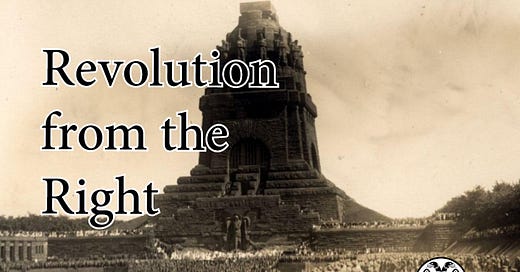It’s a great privilege and, at the same time, a burden to make your living reading and translating books. On the one hand my daily routine involves doing close readings of the best books ever written. On the other hand, my “read for pleasure” stack has basically not budged since starting this thing. You win some, you lose some.
We’ve recently translated a book from the Conservative Revolution called Revolution from the Right. The Conservative Revolution was an interesting movement that we can learn a lot from, and it arose at an interesting time—around the Weimar republic, pre- National Socialist Germany. “Weimerica” is a cool meme but our situation is different. For them, liberalism was struggling to be born. For us, it’s lashing out as it dies. For them, the state was too weak to restore the post-war order. For us, the state has power but no legitimacy.1 Still, there are parallels to today in Weimar’s cultural exhaustion, degeneracy, and the need for rebirth. This is what the Conservative Revolution was trying to bring about.
The Conservative Revolution was the alt-right of its time: a big tent movement housing a motley collection of things that didn’t always hang together, but were united in what they were not—mainstream conservatism. Just as today’s radical right is comprised of various factions (neoreactionaries, National Socialists, traditionalists, etc.), so was the Conservative Revolution, which broke down into three major headings:
Young Conservatives: Counter-enlightenment types, often with religious sensibilities. But these were not mere trads, they embraced modernity, as all these thinkers did. This heading contains many of the thinkers you know, like Oswald Spengler and Carl Schmitt, but other worthies like Arthur Moeller van den Bruck and Edgar Julius Jung.
Völkischen: Ethnonationalists, very often concerned with Indo-European history and identity, or as it was called at the time, Indo-Germanic. Includes figures such as Guido von List and Erich Ludendorff.
National Revolutionaries: The most rigorously modern and militant of the three headings, but still anti-enlightenment, often with Nietzschean undertones. Includes figures like Ernst Jünger, Friedrich Hielscher, and Hans Freyer.
Freyer published Revolution from the Right in 1931, as the Weimar republic was dying. The present article is not a book review per se, but we will take up his notion of “revolution from the right” and show how it applies today.
The basic idea is that revolution from the left is class revolution, aimed at getting the state or society to pony up the gibs for your particular class. But because class demands are easily satisfied—by ponying up said gibs—liberalism can digest and neutralize said revolution as long as it can maintain GDP.2 And it does this by essentially bribing left revolution into obedience. In fact, every such revolution only makes liberalism stronger, by assimilating the revolutionary apparatus into the state apparatus. Trade unions are the classic example: whereas once they threatened the state, now they are a supporting pillar of the state. And so, from the time of the French Revolution—itself a revolution from the left—further revolutions from the left have only served to reinforce the status quo.
But liberalism has a problem: eventually it runs out of class interests to assimilate. It has come up with solutions to this and all have only delayed the inevitable—revolution from the right. In the Weimar republic, this revolution was National Socialism, which was defeated at great cost. Today revolution from the right threatens again. To understand liberalism’s solutions and why they have failed, we must unpack this looming revolution.




